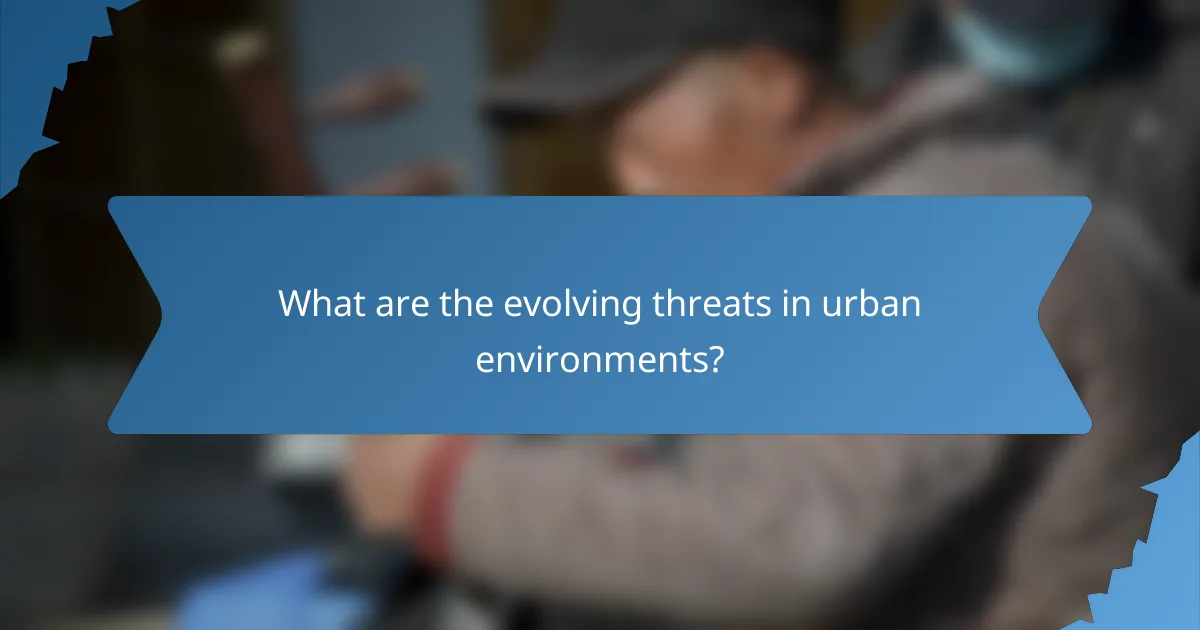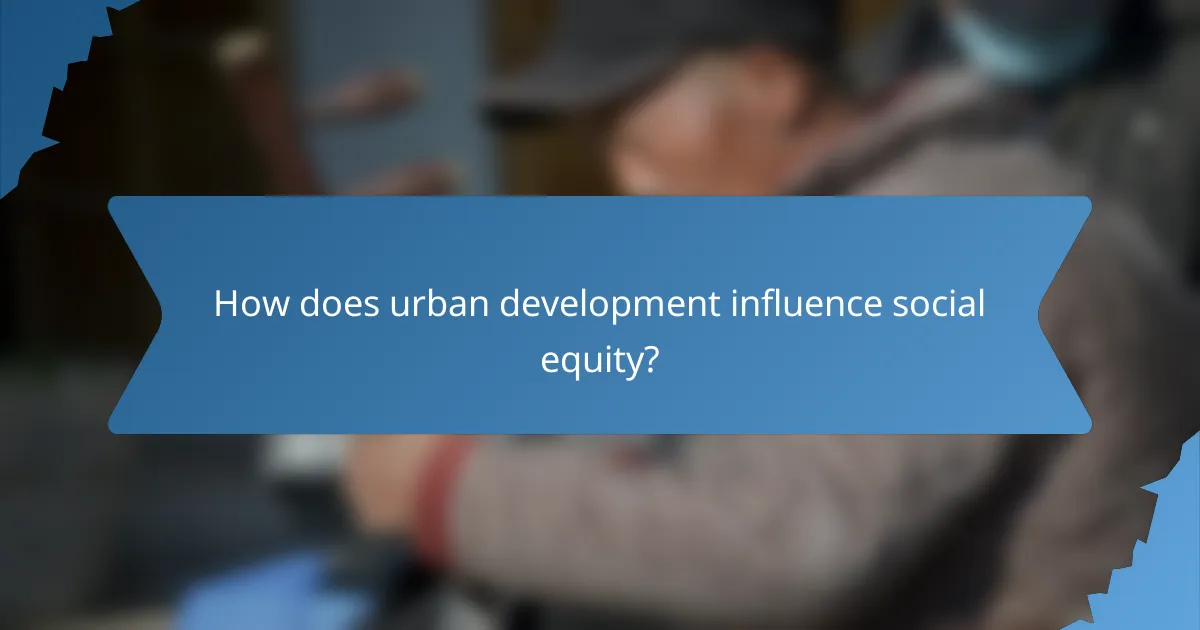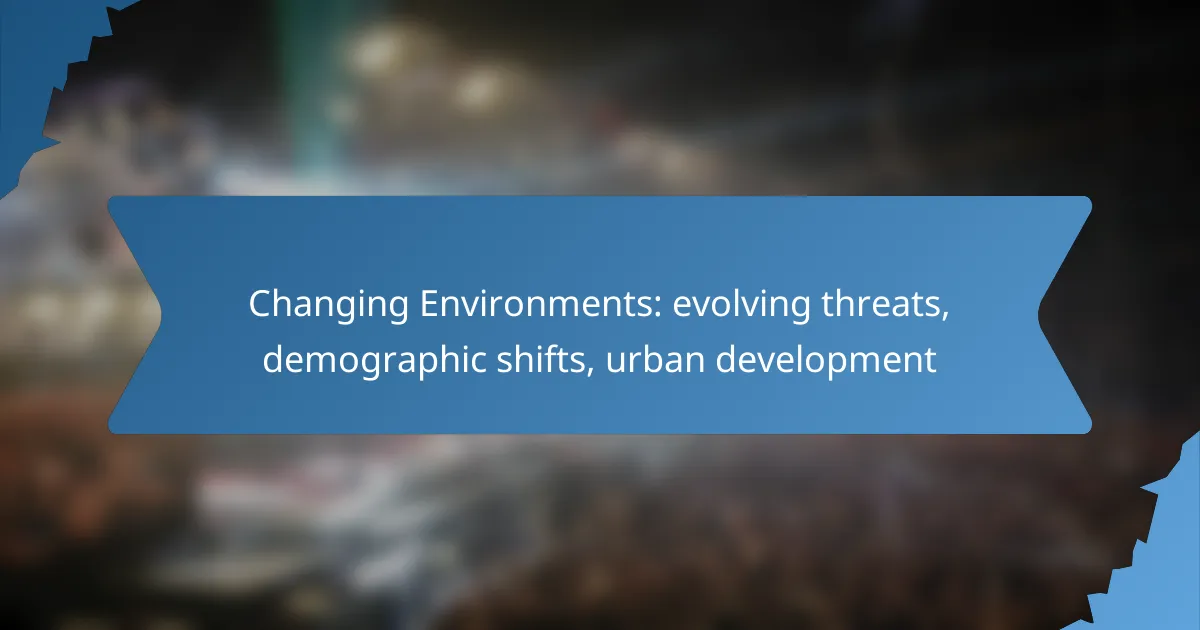As urban environments face evolving threats such as climate change, rising crime rates, and public health challenges, the need for proactive strategies becomes increasingly urgent. Demographic shifts, including an aging population and changing immigration patterns, further complicate urban development, necessitating adaptations in housing and infrastructure. Addressing these issues through smart technologies and community engagement can enhance safety, resilience, and overall quality of life for city residents.

What are the evolving threats in urban environments?
Evolving threats in urban environments include climate change impacts, increased crime rates, and public health challenges. These factors significantly affect the quality of life and safety in cities, requiring proactive measures from policymakers and residents alike.
Climate change impacts
Climate change poses significant threats to urban areas through rising temperatures, increased flooding, and extreme weather events. Cities often experience heat islands, where temperatures can be several degrees higher than surrounding areas, exacerbating health risks.
Urban infrastructure, such as drainage systems, may struggle to cope with heavy rainfall, leading to flooding. Cities must invest in resilient infrastructure and green spaces to mitigate these impacts, such as permeable pavements and urban forests that help absorb rainwater.
Increased crime rates
Urban environments often see fluctuating crime rates influenced by various factors, including economic conditions and social dislocation. Areas with high unemployment or limited access to education may experience higher crime, as individuals seek alternative means of survival.
To combat rising crime, cities can implement community policing strategies and invest in social programs that address root causes. Engaging local communities in safety initiatives can foster trust and collaboration between residents and law enforcement.
Public health challenges
Urban areas face unique public health challenges, including air pollution, limited access to healthcare, and the spread of infectious diseases. Poor air quality can lead to respiratory issues, while densely populated areas may struggle to provide adequate healthcare services.
To improve public health, cities should prioritize clean air initiatives, such as reducing vehicle emissions and promoting public transportation. Additionally, expanding access to healthcare facilities and preventive care can help mitigate health disparities in urban populations.

How are demographic shifts affecting urban development in Canada?
Demographic shifts in Canada, including an aging population and changing immigration patterns, are significantly influencing urban development. These trends necessitate adaptations in housing, infrastructure, and public services to meet the evolving needs of diverse communities.
Population aging trends
Canada’s population is aging, with a growing proportion of seniors requiring accessible housing and healthcare services. Urban development must prioritize age-friendly designs, such as barrier-free buildings and proximity to medical facilities, to accommodate this demographic.
Municipalities are increasingly focusing on creating mixed-use developments that integrate residential, commercial, and recreational spaces, allowing seniors to live independently while having essential services nearby. This approach not only enhances quality of life but also fosters community engagement.
Immigration patterns
Immigration is a key driver of urban growth in Canada, with newcomers often settling in major cities. This influx leads to increased demand for affordable housing and diverse cultural amenities, prompting urban planners to rethink zoning laws and housing policies.
To support integration, cities are developing multicultural neighborhoods that reflect the backgrounds of their residents. This includes providing community centers, language services, and culturally relevant businesses, which can enhance social cohesion and economic vitality.
Urbanization effects
Rapid urbanization in Canada is reshaping landscapes and increasing the need for sustainable development practices. As cities expand, there is a pressing need to balance growth with environmental considerations, such as green spaces and public transit systems.
Urban planners are adopting smart growth strategies that focus on density, mixed-use developments, and the preservation of natural areas. These strategies aim to reduce urban sprawl, lower transportation costs, and improve overall livability for residents.

What strategies can mitigate urban threats?
To effectively mitigate urban threats, cities can implement a combination of smart technologies, community engagement, and the development of green spaces. These strategies not only enhance safety and resilience but also improve the quality of life for residents.
Smart city technologies
Smart city technologies leverage data and connectivity to enhance urban management and safety. Examples include traffic monitoring systems, smart lighting, and environmental sensors that help cities respond quickly to emergencies and optimize resource use.
Implementing these technologies requires investment in infrastructure and training for city personnel. Cities should prioritize solutions that offer the greatest return on investment, such as those that reduce traffic congestion or improve public safety.
Community engagement initiatives
Community engagement initiatives foster collaboration between residents and local authorities, enhancing urban resilience. Programs such as neighborhood watch groups or community forums allow citizens to voice concerns and contribute to safety strategies.
To be effective, these initiatives should be inclusive and accessible, ensuring diverse community representation. Regular communication and feedback mechanisms can help sustain engagement and adapt strategies to evolving urban threats.
Urban green spaces
Urban green spaces, such as parks and community gardens, play a crucial role in mitigating threats like heatwaves and flooding. They provide natural cooling, improve air quality, and offer recreational opportunities that enhance community well-being.
When planning green spaces, cities should consider their location and accessibility to maximize benefits. Integrating green infrastructure, such as rain gardens and green roofs, can also help manage stormwater and reduce urban heat islands.

How does urban development influence social equity?
Urban development significantly impacts social equity by shaping access to resources and opportunities within communities. When cities grow, the distribution of housing, jobs, and services can either promote or hinder equitable outcomes for different demographic groups.
Affordable housing initiatives
Affordable housing initiatives are crucial for ensuring that low- and middle-income families can live in urban areas without financial strain. Programs may include subsidies, tax incentives, or zoning changes that encourage the construction of lower-cost housing options.
For instance, cities might implement inclusionary zoning, requiring developers to allocate a percentage of new units as affordable. This approach can help maintain diverse neighborhoods and prevent displacement of existing residents.
Access to public services
Access to public services, such as transportation, education, and healthcare, is vital for fostering social equity in urban environments. Effective urban planning should prioritize the equitable distribution of these services to ensure all residents can benefit.
For example, investing in public transit can connect underserved neighborhoods to job centers, while ensuring schools in all areas receive adequate funding can improve educational outcomes across demographics. Cities should regularly assess service availability and address gaps to promote fairness.

What frameworks guide sustainable urban planning?
Sustainable urban planning is guided by frameworks that prioritize environmental health, social equity, and economic viability. These frameworks help cities develop in ways that minimize negative impacts on ecosystems while enhancing the quality of life for residents.
LEED certification standards
LEED (Leadership in Energy and Environmental Design) certification standards provide a framework for assessing the sustainability of buildings and communities. This system evaluates factors such as energy efficiency, water usage, and materials sourcing to promote eco-friendly construction practices.
To achieve LEED certification, projects must meet specific criteria across various categories, including sustainable site development, water efficiency, and indoor environmental quality. For instance, a building might earn points by incorporating renewable energy sources or using recycled materials.
UN Sustainable Development Goals
The UN Sustainable Development Goals (SDGs) consist of 17 global objectives aimed at addressing pressing social, economic, and environmental challenges. These goals serve as a blueprint for sustainable urban development, encouraging cities to adopt practices that promote inclusivity and environmental stewardship.
Key goals relevant to urban planning include Goal 11, which focuses on making cities inclusive, safe, resilient, and sustainable. Urban planners can align their projects with these goals by prioritizing affordable housing, sustainable transport systems, and green public spaces.

What emerging trends shape future urban environments?
Future urban environments are increasingly influenced by resilience planning, technological integration, and decentralized urban models. These trends address evolving threats, demographic shifts, and the need for sustainable urban development.
Resilience planning
Resilience planning focuses on preparing urban areas to withstand and recover from various shocks, such as natural disasters and economic downturns. Cities are adopting strategies that enhance their ability to adapt to climate change, including green infrastructure and emergency response systems.
Key steps in resilience planning involve assessing vulnerabilities, engaging community stakeholders, and implementing adaptable policies. For instance, cities might invest in flood defenses or develop heat action plans to protect vulnerable populations during extreme weather events.
Technological integration
Technological integration in urban environments refers to the incorporation of smart technologies to improve city management and enhance residents’ quality of life. This includes the use of IoT devices, data analytics, and automation to optimize services like transportation, waste management, and energy use.
For example, smart traffic systems can reduce congestion and emissions, while energy-efficient buildings can lower utility costs. Cities should prioritize interoperability of technologies to ensure seamless communication between systems and avoid vendor lock-in.
Decentralized urban models
Decentralized urban models promote the distribution of resources and services across smaller, self-sufficient communities rather than relying on a centralized urban core. This approach can enhance local resilience and reduce pressure on infrastructure in densely populated areas.
Implementing decentralized models may involve creating mixed-use neighborhoods that support local economies and encourage sustainable practices. Cities can facilitate this by zoning for diverse land uses and investing in local public transportation options to connect these communities effectively.
